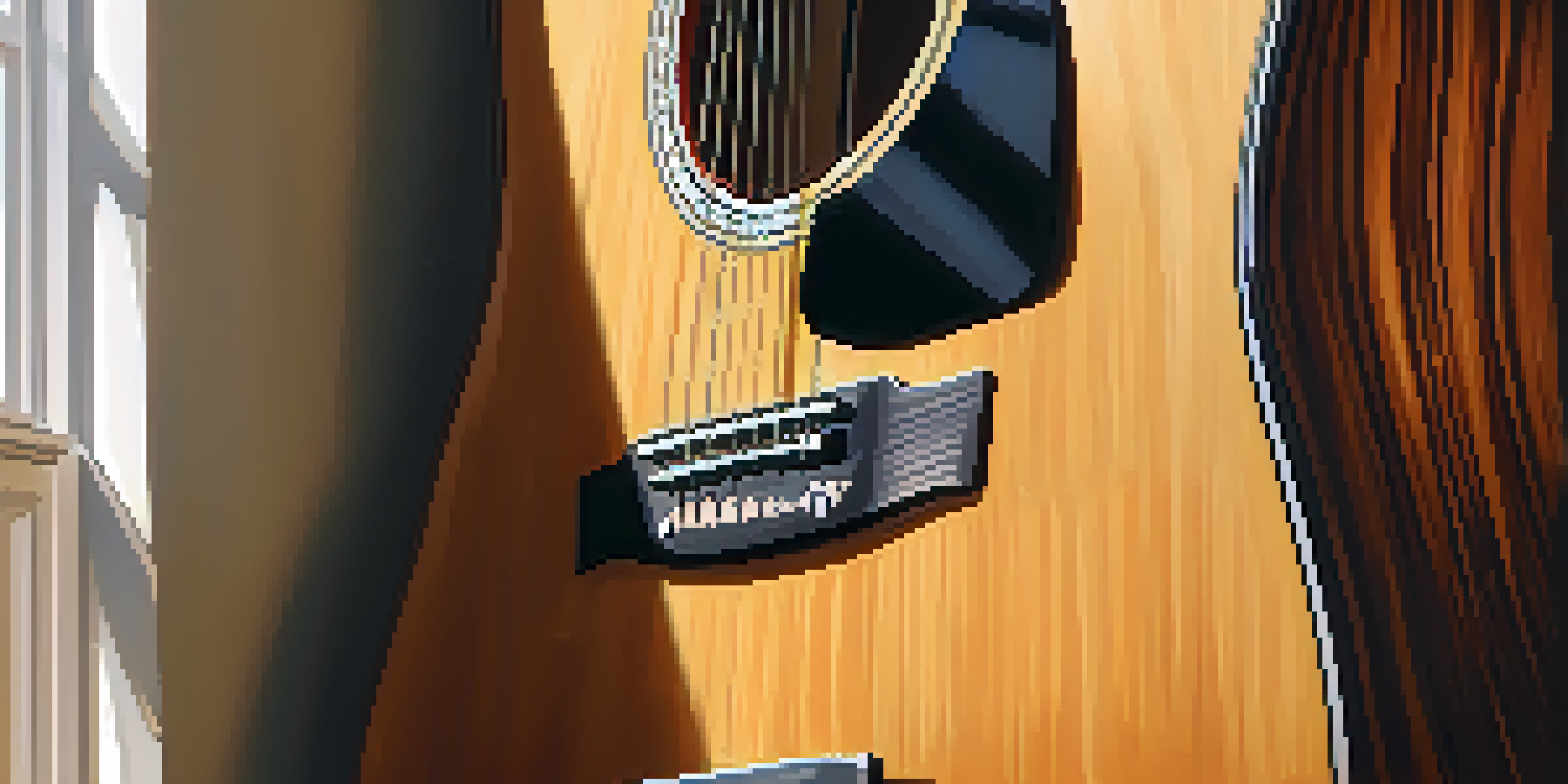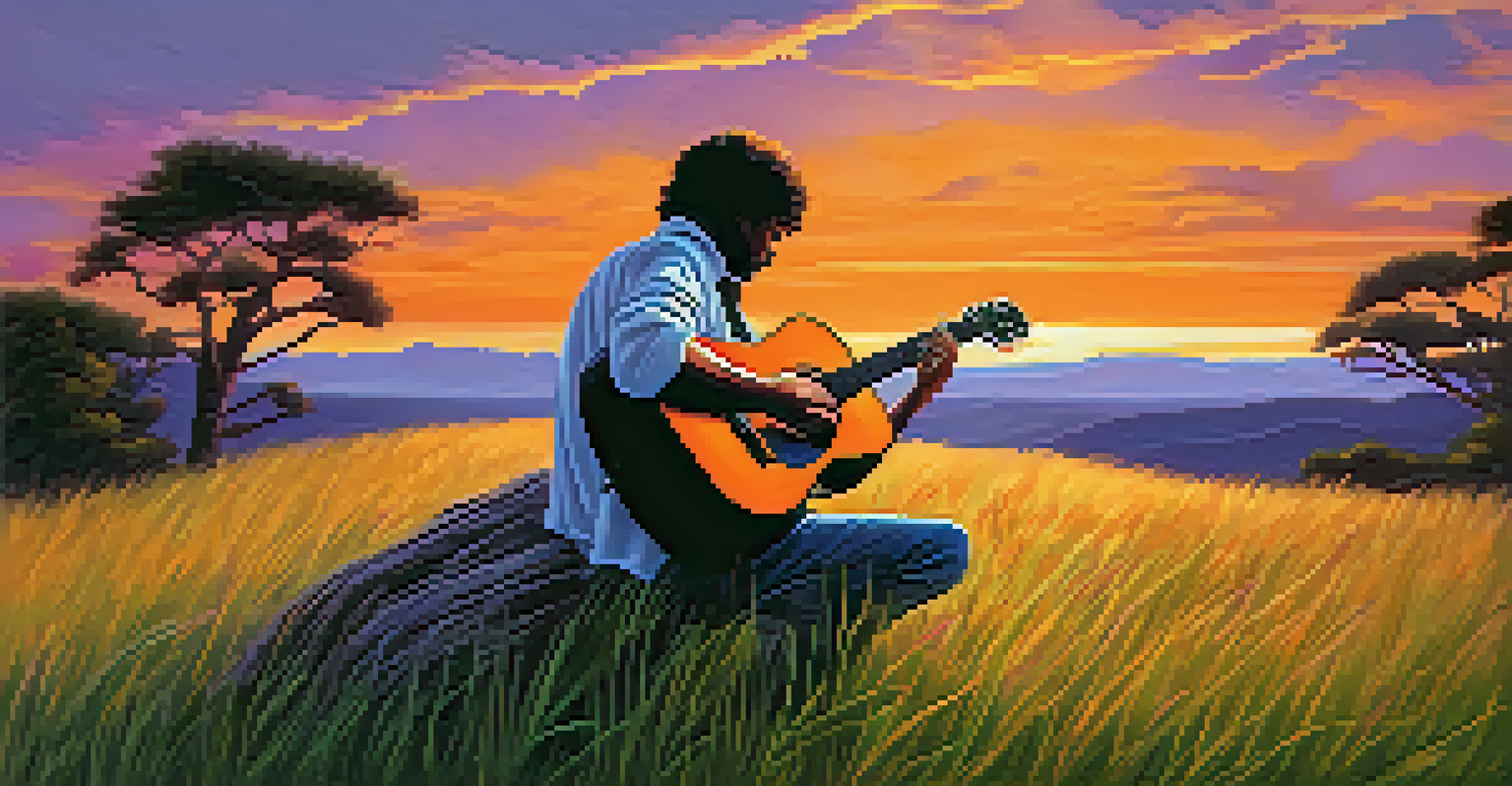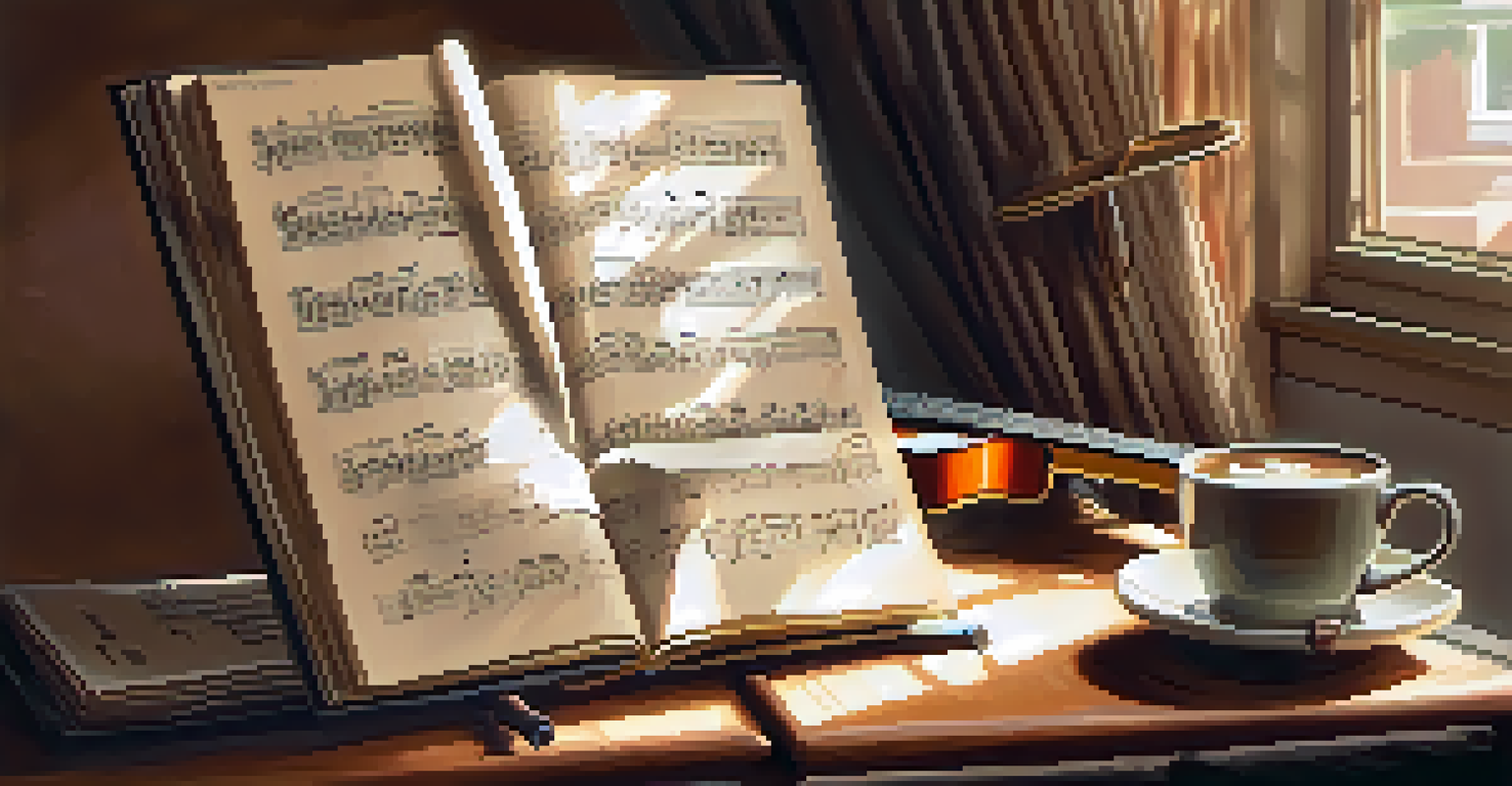Guitar as a Storytelling Tool: Crafting Narratives Through Music

The Emotional Power of Guitar in Storytelling
The guitar has a unique ability to evoke emotions, making it a powerful storytelling tool. With its varied tones and dynamics, it can express joy, sorrow, tension, and relief, similar to a character's journey in a novel. Just as a well-crafted narrative can tug at our heartstrings, so can a melody played on the guitar. This emotional resonance is what draws listeners into the story being told, creating a profound connection.
Music is the shorthand of emotion.
Consider a fingerstyle guitar piece that starts softly, building tension with each note. This mirrors the rising action in a story, where anticipation grows. As the piece crescendos, it can symbolize a climax, pulling the audience deeper into the narrative. In this way, guitarists can paint vivid pictures in the minds of their listeners, transforming simple notes into an immersive experience.
Moreover, the guitar’s versatility allows musicians to explore a range of genres, each bringing its own narrative style. From the storytelling tradition in folk music to the raw emotion of blues, the guitar adapts to convey different tales. This adaptability makes it a favorite among storytellers, allowing them to express various themes and messages through their music.
Crafting a Narrative Structure with Music
Just like a good story has a beginning, middle, and end, so does a well-composed piece of music. Guitarists can structure their compositions to reflect this narrative arc, guiding listeners through a journey. The introduction sets the scene, establishing the mood and themes, akin to the opening chapters of a book. This phase invites the audience in, creating curiosity about what’s to come.

As the composition progresses, the middle section often introduces conflict or complexity, much like a plot twist in a novel. Here, the guitar can employ different techniques, such as varying strumming patterns or modal shifts, to create tension. This mirrors the character development in a story, where challenges arise and the stakes increase, engaging listeners further.
Guitar Evokes Deep Emotions
The guitar's varied tones and dynamics can express complex emotions, creating a profound connection between the music and the listener.
Finally, the resolution in music brings a sense of closure, akin to a satisfying ending. This might involve returning to a familiar melody or resolving dissonant chords, providing relief and completion. In this way, guitarists not only entertain but also ensure their audience leaves with a sense of fulfillment, having experienced a complete narrative.
Using Lyrics to Enhance Musical Storytelling
Lyrics can significantly enhance the storytelling aspect of guitar music, adding depth to the narrative. When combined with guitar, words can create vivid imagery, allowing listeners to visualize the story being told. For example, a song about heartbreak might feature melancholic chords that echo the sorrow expressed in the lyrics, amplifying the emotional impact.
The guitar is a miniature orchestra in itself.
Think of classic folk songs that narrate tales of love, loss, or adventure. The guitar strumming alongside poignant lyrics can transport listeners to another time and place, making them feel as if they are part of the story. This synergy between music and words is what makes certain songs unforgettable, as they resonate on multiple levels.
Moreover, the performance style can also tell a story. A singer-songwriter might choose a quiet, introspective delivery for a personal tale, while a rock band might opt for an energetic, raucous approach to convey excitement. This interplay of guitar and lyrics creates a rich tapestry of storytelling, inviting listeners to engage with the music on a deeper emotional level.
Cultural Narratives Through Guitar Music
Guitar music often reflects cultural narratives, telling the stories of communities and traditions. Different regions have their own styles and techniques, which convey unique historical and social contexts. For instance, Flamenco guitar captures the passion and struggles of Spanish culture, while Delta blues tells tales of hardship and resilience from African American history.
Through these styles, guitarists become storytellers of their heritage, sharing experiences and emotions that resonate with audiences. This cultural narrative allows listeners to connect with the music on a more personal level, as they recognize the shared human experiences behind the notes. In this way, the guitar serves not just as an instrument but as a bridge between cultures and generations.
Music Mirrors Narrative Structure
A well-composed guitar piece can reflect a story's arc, guiding listeners through a journey with a clear beginning, middle, and end.
Additionally, contemporary guitarists often blend various cultural influences, creating new narratives that reflect our interconnected world. This fusion allows for innovative storytelling that speaks to modern experiences while honoring traditional roots. By embracing this diversity, guitarists can craft narratives that resonate widely, making their music both relatable and impactful.
Iconic Guitarists and Their Storytelling Techniques
Throughout history, iconic guitarists have mastered the art of storytelling through music. Consider Jimi Hendrix, whose innovative playing and emotive performances turned every song into a vivid narrative full of passion and intensity. His ability to convey complex emotions through guitar solos often left listeners feeling as though they’d experienced a journey themselves.
Similarly, artists like Eric Clapton and Bob Dylan have utilized their guitar skills to share personal and societal stories. Clapton's blues-infused ballads often reflect themes of love and loss, while Dylan's lyrics paired with simple guitar chords tell tales of protest and change. These musicians illustrate how the guitar can be a powerful voice for storytelling, blending technical prowess with emotional depth.
By studying the techniques of these legendary guitarists, aspiring musicians can learn how to infuse their own narratives into their music. They can experiment with varying techniques, dynamics, and lyrical content to create their unique storytelling style. This exploration not only enhances their musicality but also allows them to connect with their audience on a deeper level.
The Role of Improvisation in Musical Narratives
Improvisation plays a crucial role in storytelling through guitar music, allowing musicians to express spontaneity and emotion. When a guitarist improvises, they create an organic narrative that evolves in real-time, much like a conversation. This unpredictability can captivate listeners, drawing them into the moment and making each performance unique.
For instance, in jazz or blues, guitarists often take turns improvising solos, weaving personal narratives into the collective story of the song. This interplay not only showcases their technical skills but also their ability to convey emotions and experiences through spontaneous expression. Each note can represent a thought or feeling, creating a dynamic and engaging musical dialogue.
Cultural Narratives in Guitar Music
Guitar music often embodies cultural narratives, allowing musicians to share their heritage and connect with audiences through shared human experiences.
Embracing improvisation can free musicians from the constraints of a fixed narrative, encouraging them to explore new ideas and emotions. This exploration can lead to unexpected musical moments that resonate deeply with the audience, making the storytelling experience even more powerful. In essence, improvisation transforms the guitar into a living, breathing instrument of narrative.
The Future of Guitar as a Storytelling Medium
As music continues to evolve, the guitar remains a vital tool for storytelling. With the advent of technology, musicians can now blend traditional guitar sounds with electronic elements, expanding the possibilities for narrative expression. This fusion creates new genres and styles, allowing for innovative storytelling that resonates with modern audiences.
Moreover, social media platforms have made it easier for guitarists to share their narratives with a global audience. Musicians can create and distribute their stories through videos, live streams, and online collaborations, reaching listeners far beyond their local communities. This democratization of storytelling allows diverse voices and narratives to emerge, enriching the musical landscape.

As we look to the future, it’s clear that the guitar will continue to be a powerful medium for storytelling. Whether through traditional methods or innovative techniques, guitarists will find new ways to connect with their audience and share their stories. The enduring nature of this instrument ensures that it will remain a beloved tool for narrative expression for generations to come.